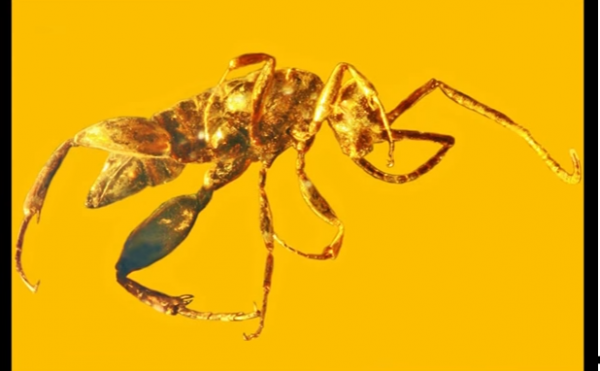By Anish Asokan, | January 28, 2017

The unique features of the insect should have helped it to survive the forests of what is formerly Myanmar 100 million years ago. (YouTube)
A 100-million-year-old insect with a triangular head has been discovered preserved in amber by the researchers at Oregon State University.
The insect has alien-like features. According to Tech Times, currently there are only 31 insect orders, and this newly discovered insect might have to be placed in its own scientific order.
Like Us on Facebook
The small wingless insect seems to be of female gender with a scary and weird looking face.It probably lived in fissures in the bark of trees and might have consumed mites, worms or fungi. The omnivore had long, narrow, flat body with slender long legs.The glands on the neck of this insect could have secreted a deposit which would have been some chemical to repel predators.
According to George Poinar, Jr., an emeritus professor of entomology at the OSU College of Science and one of the world's leading experts on plant and animal life forms found preserved in the semi-precious stone amber, the insect had large features which do not match with any existing or pre-existing insect species. This newly discovered insect species was capable of seeing almost 180 degrees by turning the head sideways.
The insect has been named Aethiocarenus burmanicus in reference to the Hukawng Valley mines of Myanmar where it was found and assigned to the newly assigned order Aethiocarenodea, the 32nd classification of groups of insects that science recognizes.
The unique features of the insect should have helped it to survive the forests of what is formerly Myanmar 100 million years ago, according to Phys. However, for reasons unknown, the insect vanished. Perhaps, the loss of habitat could have been the reason behind the extinction.
These findings have been released in the journal Cretacous Research.
-
Use of Coronavirus Pandemic Drones Raises Privacy Concerns: Drones Spread Fear, Local Officials Say

-
Coronavirus Hampers The Delivery Of Lockheed Martin F-35 Stealth Fighters For 2020

-
Instagram Speeds Up Plans to Add Account Memorialization Feature Due to COVID-19 Deaths

-
NASA: Perseverance Plans to Bring 'Mars Rock' to Earth in 2031

-
600 Dead And 3,000 In The Hospital as Iranians Believed Drinking High-Concentrations of Alcohol Can Cure The Coronavirus

-
600 Dead And 3,000 In The Hospital as Iranians Believed Drinking High-Concentrations of Alcohol Can Cure The Coronavirus

-
COVID-19: Doctors, Nurses Use Virtual Reality to Learn New Skills in Treating Coronavirus Patients







